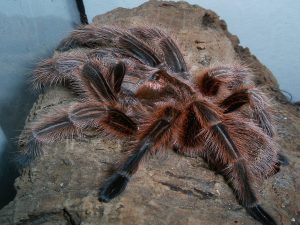Chilean Rose Tarantula
Grammostola rosea

Chilean Rose Tarantulas are among the most docile and low maintenance of the Tarantulas. They are mostly content to sit in their burrows a majority of the time, only emerging to feed.
In recent years, they have become less common within the pet trade.
Sometimes they display quirky behaviour, such as rearranging sticks or stones in their tank. Although docile to humans, you must only keep one Tarantula per enclosure or they will fight, and Females are likely to eat the Males.
They are native to Desert scrub areas of Chile, Argentina and Bolivia.
Latin Name: Grammostola rosea
Difficulty Level: Beginner
Temperament: Docile
Life Span: 5 Years – Male ¦ 15 – 20 Years – Female
Size: Up to 12.5cm Leg Span (Females are larger)
Habitat: Desert Scrubland
Diet: Live Insects – Crickets, Locusts etc.
You should Gut-Load the insects with veggies and feed to the Tarantula 1 – 2 times per week.
Avoid Frozen or Dead Food.
Supplements: None
Hours of Activity: Nocturnal – Chilean Rose Tarantulas are more likely to be active at night but will take prey at any time.
Handling: Carefully – The spider may occasionally bite if startled. They can also flick their irritating hairs when threatened, aiming for the face of the offending person.
Be very careful not to drop the Spider, as this can seriously injure or even kill it outright. Tarantulas are one of the heaviest terrestrial animals with an exoskeleton, and as such, can not tolerate falls from heights of more than about 2 feet.
Temperature:
Room temperature is fine for these tarantulas.
Around 18°C – 22°C
Be aware that higher temperatures are detrimental and may even kill the Spider.
Humidity: 65%
Vivarium Size: 30cm x 30cm (Minimum)
Substrate Type: Peat Moss, Soil, Coconut Fibres.
Equipment Necessary: Glass Tank, Thermostat, Thermometer. A heat mat may be necessary for colder months.
Cleaning Instructions: Spot clean any uneaten food and remains. Clean substrate once per month to avoid bacterial growth.
Healthy Behaviours: Coming out of their burrow at night to hunt, Feeding well.
Sick Behaviours: Not feeding, Lethargy.
Give the spider at least 4 inches of substrate in which to make its burrow.
They must be given fresh, clean water daily. This can be done via misting.
Chilean Rose Tarantulas moult once or twice per year. This can take anywhere from minutes to hours.
Whilst moulting, it may look like the spider is dying. They tend to stop eating in the days leading up, then roll over onto their backs before the process begins.
Do not touch the spider while it is moulting. This can kill the spider due to stress and shock. They are very vulnerable during and after moulting, so may display more aggression.
Like a lot of spiders, the Male is at serious risk of being eaten when trying to mate. If you attempt to breed your spiders, be sure to remove the Male as soon as the deed is done, lest he become the Female’s dinner.
Sometimes this is unavoidable, as if the Female isn’t receptive to his advances, she will see him as prey and attack.
When threatened, the Spider is likely to flick hairs with its back legs, aiming at the face of the perceived threat. Failing this, the spider will rear up and display its fangs as a final warning before resorting to biting.
Common Problems:
No common problems, as long as the Spider is well cared for. They are typically a very hardy Tarantula.
The only problem worthy of note is if their new carapace doesn’t harden after moulting, or the moulting process itself takes a long time. In which cases, seek veterinary advice.
